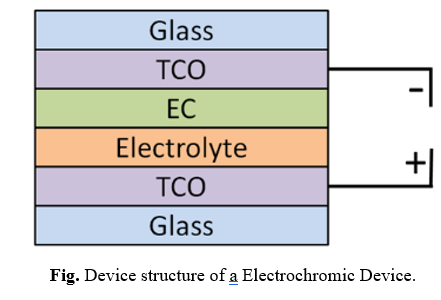Video Article Open Access
Electrochromic Properties of WO3 Using Different Transparent Conducting Oxide Electrodes
Kah-Yoong Chan*, Benedict Wen-Cheun Au
Centre for Advanced Devices and Systems (CADS), Faculty of Engineering, Multimedia University, Cyberjaya Campus, Cyberjaya, 63100, Selangor, Malaysia
Vid. Proc. Adv. Mater., Volume 3, Article ID 2208336 (2022)
DOI: 10.5185/vpoam.2022.08336
Publication Date (Web): 26 Nov 2022
Copyright © IAAM
Graphical Abstract

Abstract
Electrochromism is the phenomena of inducing a reversible optical change (colouring and bleaching) in electrochromic (EC) materials under the influence of a small electric field. It has become increasingly important in energy-saving applications such as smart windows in smart buildings which are in line with the rapid expansion of Internet of Things. Electrochromism is the backbone of the smart windows technology. In the state-of-arts electrochromic device (ECD) technology, it consists of an electrolyte layer and an EC layer sandwiched between two transparent conducting oxide (TCO) layers. Each layer has its own function where the two TCO layers serve as the conducting electrodes, electrolyte layer as ion conducting layer and EC layer as the colour changing layer. Tungsten oxide (WO3) is an n-type semiconductor used in a wide range of applications including EC smart windows, rear-view mirrors and sensors. In smart windows, WO3 is an important component as EC layer, where it is responsible for the changing of its optical transmittance. In this work, WO3 films were deposited on indium doped tin oxide (ITO) and fluorine doped tin oxide (FTO) glass substrates, respectively, through sol-gel spin-coating method. ITO and aluminium doped zinc oxide (AZO) coated glasses were used as counter electrodes, respectively, in the construction of electrochromic devices (ECDs). The optical transmittance of the ECD was characterised by the ultraviolet-visible (UV-Vis) spectrophotometer and the EC properties were characterised by the cyclic voltammetry (CV) and chronoamperometry (CA) techniques.
Keywords
Electrochromic; electrochromic device; sol-gel; transparent conducting oxides.
Acknowledgement
This work is funded by the Fundamental Research Grant Scheme (FRGS 2020-1) under Ministry of Higher Education (MOHE), Malaysia (Project Ref: FRGS/1/2020/TK0/MMU/02/2). We would like to extend our sincere gratitude and appreciation to MOHE for financially supporting this work.
Biography
Kah-Yoong Chan obtained his Ph.D. in Electrical Engineering from Jacobs University Bremen in Germany in year 2008. He is a Professional Engineer with Practicing Certificate (PEPC) with BEM, a senior member with IEEE, and a corporate member with IEM. Ir. Dr. Chan research areas are in the Smart Electronics, Internet of Nano Things (IoNT), micro and Nanoelectronic device fabrications and characterizations. Currently, he is an Associate Professor with the Faculty of Engineering in Multimedia University and serves as a Chairperson for a Research Center under the Faculty of Engineering of MMU - Centre for Advanced Devices and Systems (CADS).
Video Proceedings of Advanced Materials

Upcoming Congress



